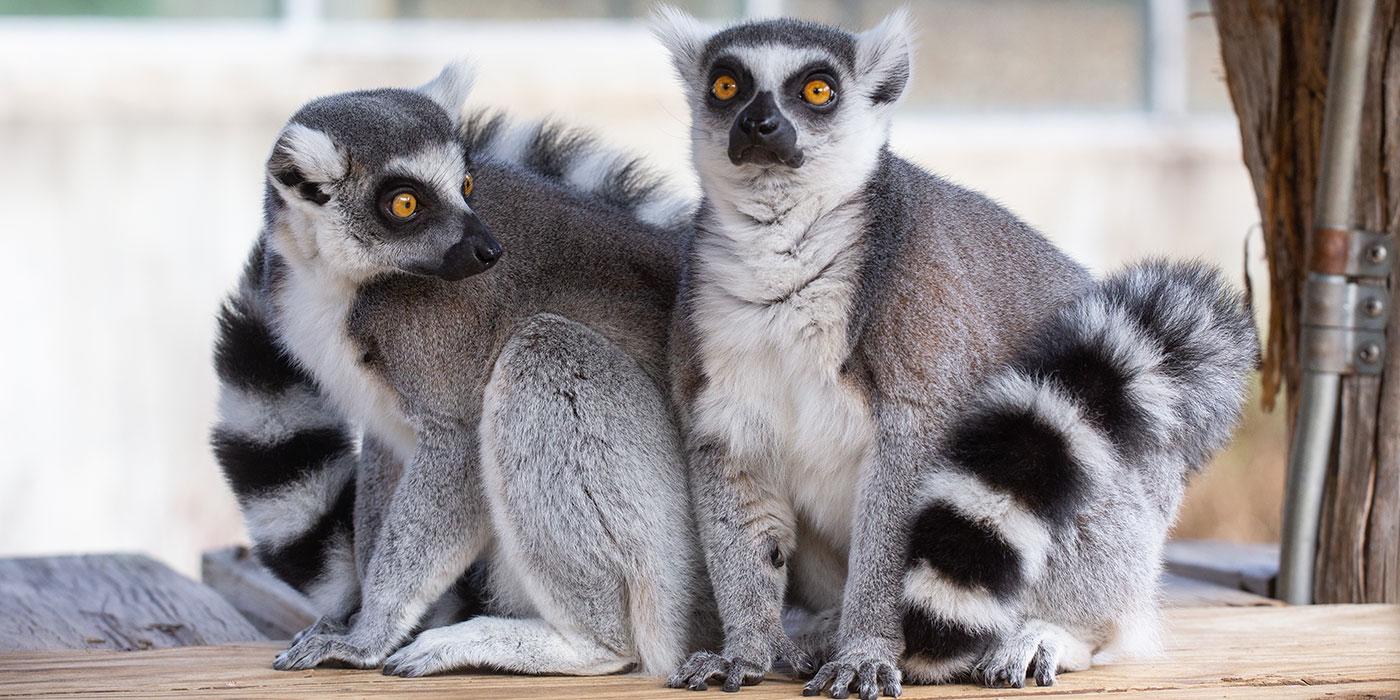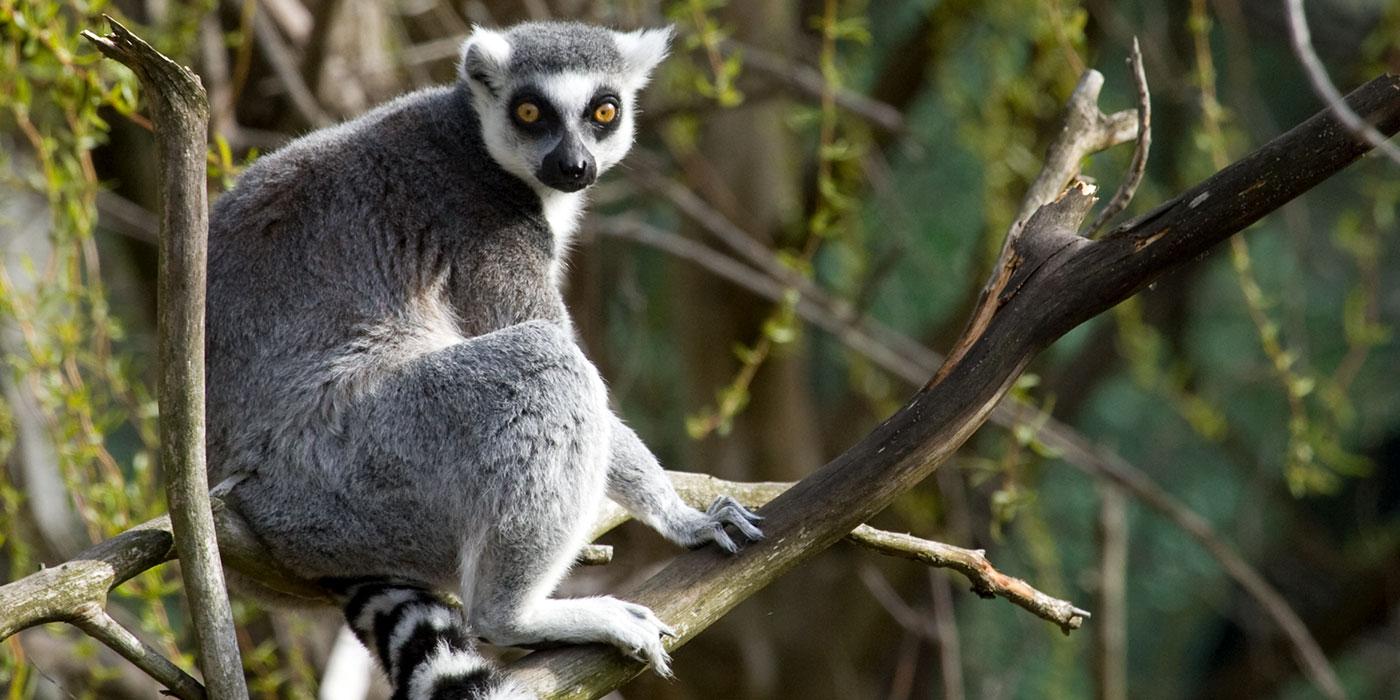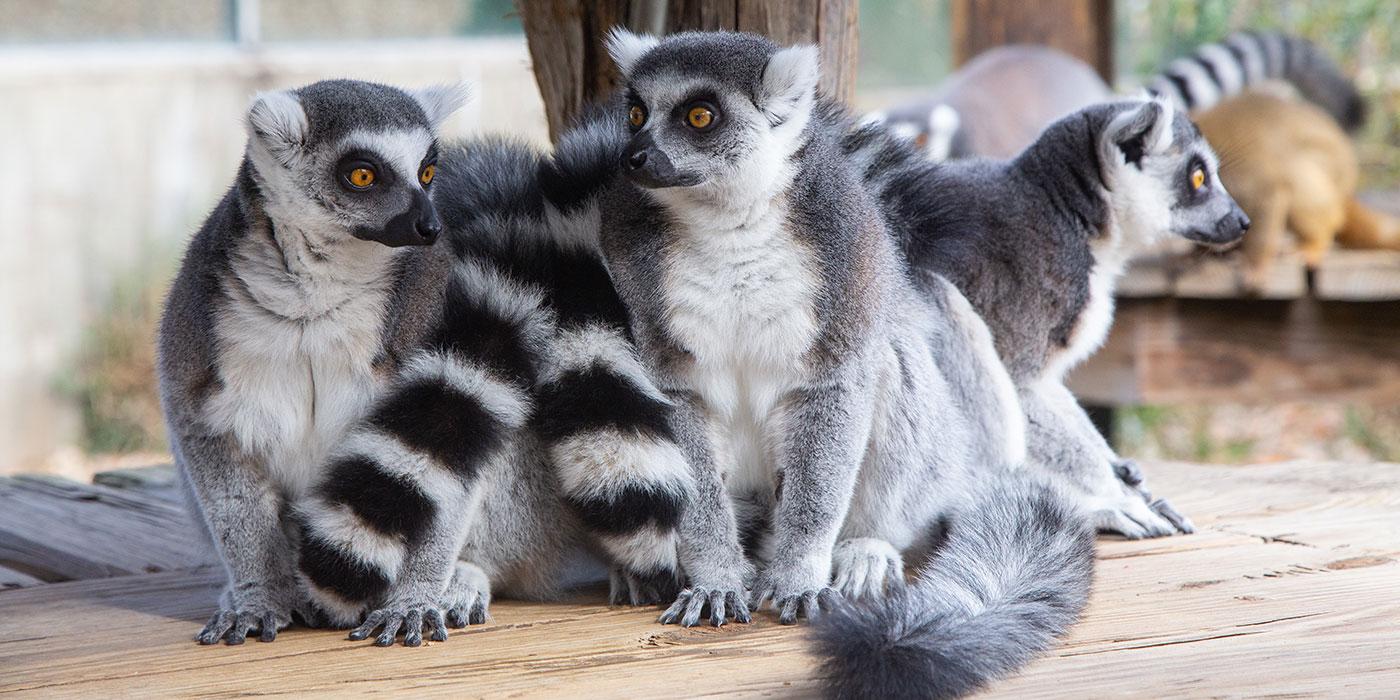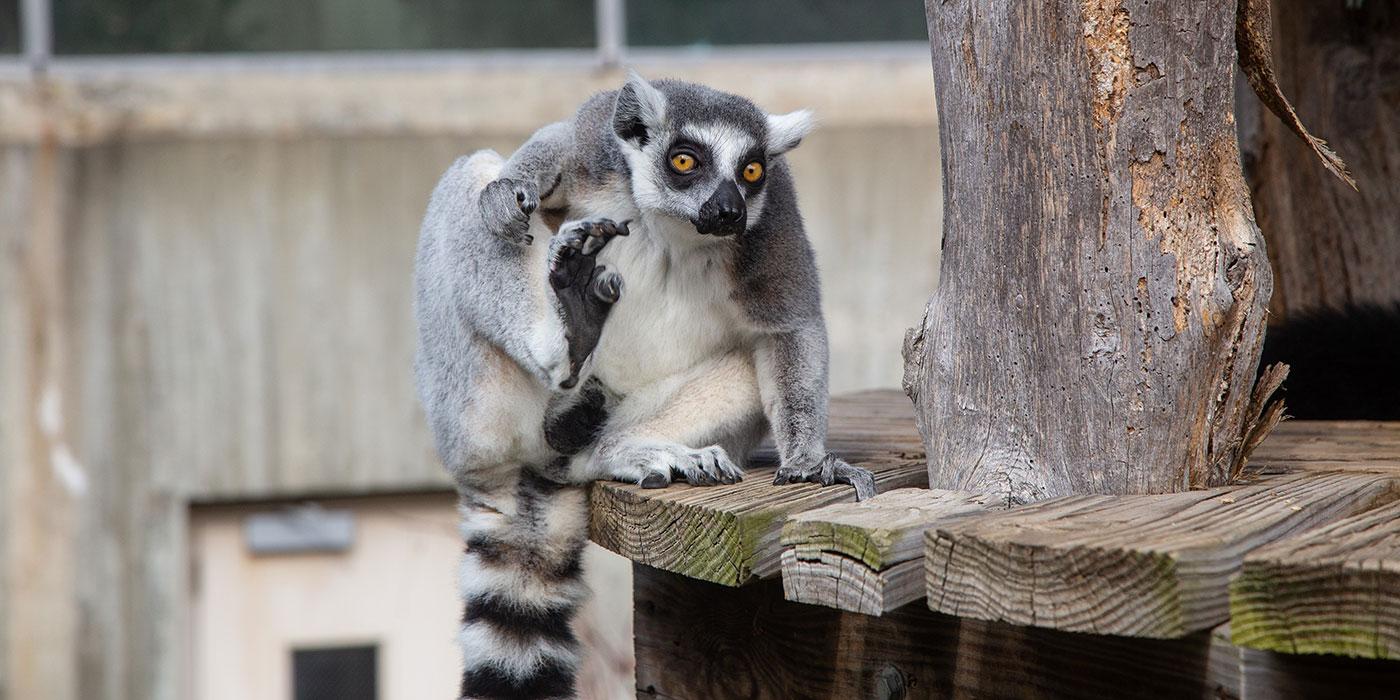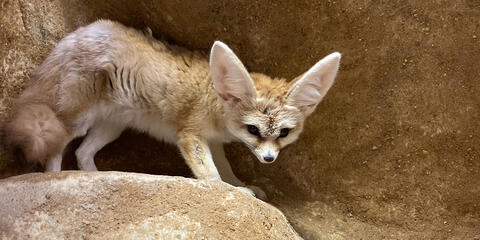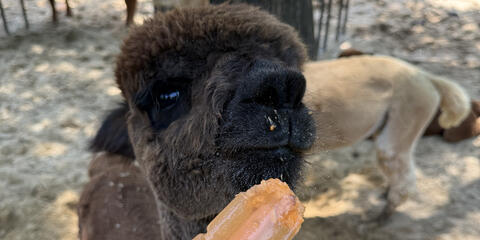Ring-tailed lemurs are named for the 13 alternating black and white bands that adorn their tails. Unlike most other lemurs, ringtails spend 40 percent of their time on the ground, moving quadrupedally along the forest floor.
Physical Description
Ring-tailed lemur backs are gray to rosy brown with gray limbs and dark gray heads and necks. They have white bellies. Their faces are white with dark triangular eye patches and a black nose. True to their name, ring-tailed lemurs' tails are ringed with 13 alternating black and white bands.
Unlike most other lemurs, ringtails spend 40 percent of their time on the ground. They move quadrupedally along the forest floor.
Size
The average body mass for adult males is 6 pounds (3 kilograms). Females are usually smaller. Their tails can be up to 2 feet long (61 centimeters).
Native Habitat
Ring-tailed lemurs live in southwestern Madagascar, in arid, open areas and forests in territories that range from 15 to 57 acres (0.06 to 0.2 square kilometers) in size.
Lifespan
The median life expectancy for a ring-tailed lemur is about 16 years.
Communication
As with all lemurs, olfactory communication is important for ringtails. Ring-tailed lemurs have scent glands on their wrists and chests that they use to mark their foraging routes. Males even have a horny spur on each wrist gland that they use to pierce tree branches before scent marking them. Secretions from the wrist glands can also be rubbed on the tail and flicked at an opponent.
Ring-tailed lemurs communicate visually in a number of ways as well. When ring-tailed troops travel throughout their home range, they keep their tails raised in the air, like flags, to keep group members together. They also communicate using facial expressions:
- Staring, open-mouth face: The eyes are opened wide, and the mouth is open with the teeth covered by the lips. This occurs when mobbing a predator, or serves to communicate a threat.
- Staring, bared-teeth scream face: The eyes are opened wide, and the mouth is open with the corners drawn back so that the teeth and gums are revealed. This display occurs with terror flight.
- Silent, bared-teeth face: The eyes are staring at the stimulus, the eye brows are either relaxed or up, and the corners of the mouth are drawn back, allowing the teeth to show. This is used to communicate submission or a friendly approach.
- Bared-teeth gecker face: Similar to "silent bared-teeth face" only with a rapid noise attached to it. This display occurs during subordinate flee-approach conflicts and when an infant is bothered. The term "gecker" refers to the distinct noise made.
- Pout face: The eyes are opened wide, and the lips are pushed forward such that the mouth resembles an "O" shape. This occurs with contact calls and begging.
- Hoot face: The lips are pushed forward to resemble something called a "trumpet mouth." This display occurs with long-distance calls (e.g. territorial calls).
Ring-tailed lemurs are one of the most vocal primates. They have several different alarm calls to alert members of their group to potential danger:
- Infant contact call: soft purr
- Cohesion call: cat's meow; used when the group is widely dispersed
- Territorial call: howl; can be heard for over a half a mile (1 kilometer).
- Alarm call: starts as a grunt then becomes a bark.
- Repulsion call: series of staccato grunt sounds that occurs between two individuals.
Food/Eating Habits
Ringtails eat leaves, flowers and insects. They can also eat fruit, herbs and small vertebrates.
At the Smithsonian's National Zoo, they are fed a mixture of fruits, vegetables and leaf-eater biscuits multiple times a day.
Social Structure
Ring-tailed lemurs live found in social groups ranging in size from three to 25 individuals. The groups include multiple males and females. Females spend their whole lives in their birth group. Generally males change groups when they reach sexual maturity at age three.
Ring-tailed groups range over a considerable area each day in search of food, up to 3.5 miles (6 kilometers). All group members use this common home range, and groups are often aggressive towards other groups at the borders of these areas.
Females are dominant within groups, meaning females have preferential access to food and choice of whom to mate with. This is unusual in the primate world. Males do have a dominance hierarchy, though even low-ranking males are able to mate. The hierarchy among ring-tailed lemur females is not linear, and daughters do not always assume the rank of their mothers. One explanation for this pattern is that ring-tailed lemur mothers do not support their daughters in social interactions, so the daughters do not inherit rank but fight to achieve their own rank.
Females have been seen to have closer social bonds with other female relatives in a group than they do with unrelated females. These social bonds are established and reinforced by grooming. Prosimians groom in a rather unique way. All prosimians have six lower teeth, incisors and canines that stick straight out from their jaw, forming a comb. This comb is used to groom their fur and the fur of the other members of their social group.
Reproduction and Development
Females usually give birth to their first baby when they are three years old, and usually once a year every year after that. But, in human care, females can have their first offspring as early as 18 months old. Females are sexually receptive for one to two days each year, and estrus may be as short as 6 to 24 hours. In the wild, mating is seasonal beginning in mid-April, with infants being born in August and September. Gestation lasts 4.5 months. Generally, ring-tailed lemurs give birth to one offspring, but twins can be frequent if food is plentiful.
Initially, infants cling to their mothers' bellies, but, after approximately two weeks, they can be seen riding jockey-style on their mother's backs. Infants begin sampling solid food after about a week and will become increasingly independent after about a month. They return to mom to nurse or sleep until they are weaned at about five or six months of age. All adult females participate in raising the offspring of the group.
Conservation Efforts
Lemurs are the most endangered mammal group in the world.
Ring-tailed lemurs are an endangered species. Population fragmentation is a major threat to these lemurs, mostly due to human-induced habitat loss and degradation. In some regions, ring-tailed lemurs are hunted with dogs for food. They are also found in the pet trade.
Habitat destruction is the primary threat to lemurs. Since humans arrived on Madagascar about 2,000 years ago, roughly eighty percent of the total forest cover has been lost due to extraction of precious hardwoods, fuel wood, and other products, as well as to clear land for agricultural and grazing lands. On the western side of the island forests are being cleared for pasture, while in the east, the forests are burned for slash-and-burn agriculture and cut for charcoal production.
Malagasy people rely heavily on the land for their survival, which has led to the over-exploitation of natural resources throughout the island as impoverished people do whatever they can to feed their families. Illegal logging and agricultural fires are additional threats to lemur habitat, which result in both habitat loss and fragmentation. Habitat fragmentation can lead to population isolation for lemurs, resulting in an unsustainable genetic pool. Lemurs are also hunted as food items, and have an increasing presence in the illegal pet trade.
In July 2013, IUCN's Species Survival Commission (SSC) released a 185-page strategy to conserve Madagascar's lemurs. This report outlined a series of actions that needed to be taken in order to conserve lemurs and their habitat, which includes working with and training local communities, growing primate-centric ecotourism, maintaining and creating long-term research projects, and establishing and preserving a captive population of endangered lemurs.
Help this Species
- Reduce, reuse and recycle — in that order! Cut back on single-use goods, and find creative ways to reuse products at the end of their life cycle. Choose recycling over trash when possible.
- Be a smart consumer. Choose products made with sustainable ingredients, such as Smithsonian certified Bird Friendly coffees, which support farmers striving to limit their impact on wildlife and habitat.
- Practice ecotourism by being an advocate for the environment when you’re on vacation. During your travels, support, visit or volunteer with organizations that protect wildlife. Shop smart too! Avoid buying products made from animals, which could support poaching and the illegal wildlife trade.
- Share the story of this animal with others. Simply raising awareness about this species can contribute to its overall protection.

